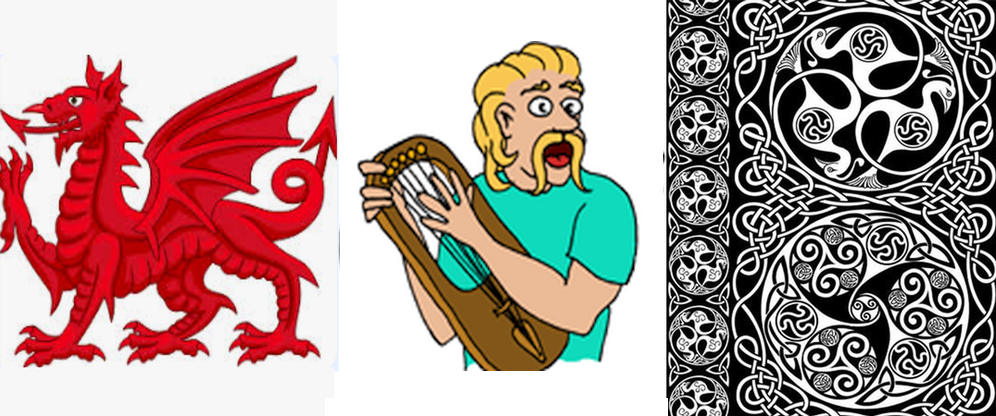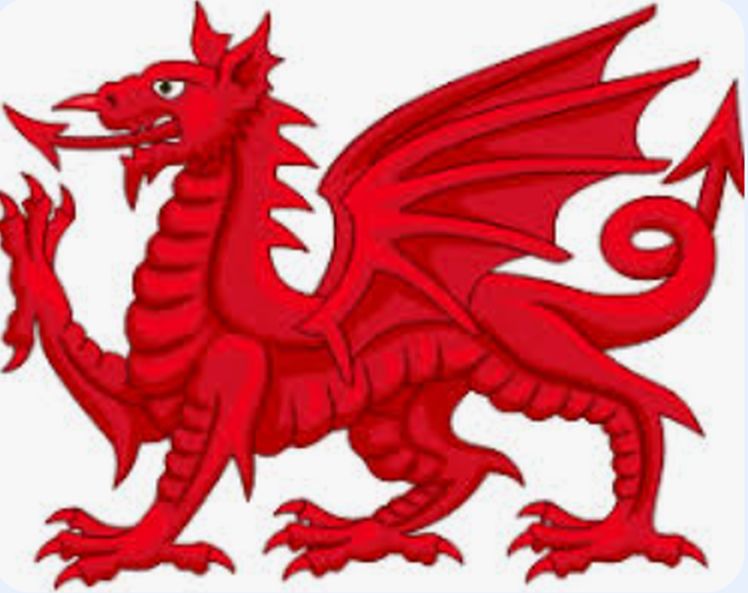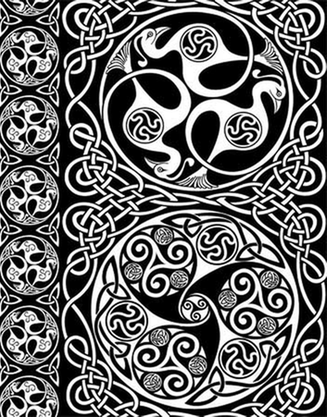Magnificent Mabinogi 6: Mythology or literature?

Dr Shân Morgain
Is the Mabinogi a Celtic mythology? Many would say yes of course, and this idea has a long history of over 150 years. However there is a still older view – and a newer one.
So broadly, there are three main schools of thought about what the Mabinogi is, and mythology is only one of them. This is a story of survival, scholarship, secrets, and scandals.
(This article is about Pedeir Cainc y Mabinogi/ the Four Branches of the Mabinogi, The similarly named Mabinogion is eleven mediaeval Welsh tales, which always includes the Mabinogi. The Mabinogi also appears on its own. See previous article)
The Welsh Tradition – British history and romance

The Mabinogi was compiled around 1100 when the Normans were first invading.
It had a single composer, or a close working partnership/ group. Its various tales come from different parts of the Cymru/ Wales, and some seem older than others.
Its earliest surviving manuscript dates about 1250, a two page remnant: Peniarth 6. The complete Mabinogi survives in Llyfr Gwyn Rhydderch (White Book) c. 1350, and in Llyfr Coch Hergest (Red Book) c. 1400 – all hot political dates. (See Politics, next week)
After Glyndŵr’s Rising ended there was little Welsh nobility or uchelwr left to sponsor bards or manuscripts. The three MSS. which survived were kept in private family libraries and studied by antiquarians.
Diana Luft has recently investigated 18thC Mabinogi scholars who generated a Welsh Renaissance. This was passionate work to reclaim Welsh history and culture as a conquered nation.
Luft found the Mabinogi valued as a respectable source for ancestral Welsh society.
Edward Lhuyd wrote an early account of the Mabinogi in Latin in Archaeologia Britannica (1706). Lhuyd is said to dismiss the Mabinogi as fabulosas/ fantasies. He actually describes it in detail as fictional accounts of ancientlBritish leaders.
Lhuyd died in a terrible scandal of debt at Oxford university (there were no Welsh universities). Quarrels about his belongings included the Llyfr Coch manuscript found in his room, which ended up at the Bodleian Library, Oxford.
Moses Williams and William Thomas, also Oxford scholars, like Lhuyd, saw the Mabinogi as a historical source for old Welsh society. Luft considers they intended to publish the Mabinogi.
Lewis Morris, eldest of the Morris brothers of Anglesey, according to Luft, may have included the Mabinogi in a planned literature and history publication.
William Owen Pughe holds the crown as the first successful Mabinogi publisher in modern print, and translator to English (1795– 1830).
A powerful literary triad developed: Pughe, Iolo Morgannwg and their wealthy benefactor Owain Myfyr. I do like Myfyr whose generosity was immense, and as a respected elder he scandalously married his beloved maid.
Pughe was the leading Welsh scholar of the period. His friendship with Iolo broke down due to Iolo’s envy and laudanum habit (which fed his creative constructions of old manuscripts). Based in the London Welsh societies, Pughe published most of the First Branch, a summary of the Second, and much of the Fourth.
Pughe has been criticised for failing to publish the whole Mabinogi in 1800 when he had financial backing. He is blamed for his distraction by the powerful Joanna Southcott cult. This overlooks his inheriting an estate which both liberated and burdened him. He then suffered three major bereavements in quick succession.
However he then made valiant efforts to salvage his Mabinogion project. He died June 1835 with the completed project ready to print, on his desk.
Charlotte Guest
Leading Welsh scholars lost no time in recruiting the wealthy, young highly energetic English wife of John Guest.
She was inspired by Thomas Price ‘Carnhuanawc’, and aided by Thomas Jones ‘Tegid’. With their powerful help she published the first complete modern version of the Mabinogion (1838–45) with Welsh and English text, still very popular today.
Thomas Stephens’ Literature of the Kymry (1849) declares ‘Europe owes its romantic literature to the Welsh and Bretons’.
This Romance concept includes our modern idea of a love story, but equally involves adventure and enchantment.
The English Tradition – Celtic myth

In the later 19thC the British Empire ruled the world.
New ideas were mixing from archaeology and the study of religions. Native religions were of course inferior to the white man’s Christ, but fascinating to study.
Anti-Christian movements were building via the occult and the arts. An ancestral ‘Celtic’ religion especially fired imagination.
Matthew Arnold, eminent English poet, liked Welsh poetry as an ancient Celtic tradition but he and his Government policy wanted the Welsh language stamped out.
Arnold famously thought the Mabinogi storytellers were fools who did not understand it. (Patrick Ford, 1981, says this shows Arnold didn’t either.)
John Rhŷs first Professor of Celtic at Oxford, in his famous Hibbert Lectures (1888) tried to reclaim a ‘Celtic pantheon’ from the puzzling, broken remains of myths, to be like the prestigious Greek Olympiad.
He regretted the dominant theory of solar-chthonic deities from Max Müller did not fit with ‘Welsh myth’. So he altered the myth – an initiative which reverberated.
Edward Anwyl is the first substantial scholar of the Mabinogi in its own right (1897– 1911). Based at the new university college of Aberystwyth, he drew upon Frazer’s Golden Dawn, for a seasonal horse/ mother Goddess myth. He also proposed the Mabinogi as three literary Cycles or family sagas, centred on Pryderi.
William John Gruffydd Rhiannon (1953) used Anwyl’s theories without crediting him. A passionate nationalist and ruthless politician, ‘WJG’ suppressed Anwyl, and ‘reconstructed’ the Mabinogi many times until his construct barely resembled the original.
Rhŷs and Gruffydd ‘Mythological Reconstruction’ dominated much of the 20thC Mabinogi and fed into the Celtic Mythology of the New Age.
The American Tradition – Genius literature

The 1970s as in so much else, shifted the paradigm.
American scholars crossed the ocean to study at Welsh universities, and pioneered a new wave.
John K. Bollard insisted that far from incoherent fragments, the Mabinogi is a skilfully unified work of fine literature (1970, 1974, 1983). He compared its intricacy to mediaeval Celtic knotwork, twisting the plot threads (interlacings).
Patrick K. Ford (1977, 1981) richly balances mythological and structural analysis with a new translation.
Andreas Pennar (1975, UK) and Rob Valente (1986) look beyond the overwhelming Goddess images to the human women behind those masks.
Charles William Sullivan III collected key articles in his vital anthology Mabinogi Essays (1996) which chronicled the transition from mythology to literature.
Jessica Hemming (PhD, 1995 and later); Will Parker (MSc1998, online 2002) also chronicled the development of Mabinogi Studies. Parker pioneered a new Mabinogi translation online.
Sullivan, Hemming and Parker broadly describe two Mabinogi stages: 19thC mythology shifting 1970s/ 1980s to literature. My chronicle adds an earlier stage using Luft’s 19thC research and more of my own to assert a native Welsh Renaissance for the Mabinogi.
I sometimes call the third (literature) approach the Coherence Paradigm, or ‘Trusting the Text’.
Frequently what seems a muddle isn’t, if we look at what the audience then would understand without explanations.
To sum up, the three main stages of Mabinogi Studies are 1) Historical source & Romance 2) Celtic Mythology 3) Genius literature.
I acknowledge my position in the third stage view of the last 50 years, though I enjoy both the others as valid.
…………………………………………………………………………………………………..
REFERENCES All scholars referenced can be found in my Mabinogi Bibliography, and the date given above should be adequate to identify which work is meant.
Questions or comments are always welcome. You can contact me via LinkedIn or Academia.edu
The ‘Magnificent Mabinogi’ title was first used by the playwright director Manon Eames for her famous staging, Aberystwyth Arts 2008; used here with her permission.
‘Magnificent Mabinogi’ series. 1) Genius 2) Stories 3) Howlers 4) Tensions 5) Places of power 6) Myth or literature? (above) NEXT 7) Politics
Support our Nation today
For the price of a cup of coffee a month you can help us create an independent, not-for-profit, national news service for the people of Wales, by the people of Wales.





My own view is that the Mabinogi is a fragment of a lost mythology. This would explain its lack of an overarching theme and the appearance and rapid disappearance of characters like Dylan. Either this character had a fuller story now lost or he is nothing more than a literary doodle.
Yes you;re right there are refs like Dylan, mentioning another story. I think the Mabinogi project was like a compendium, so it refers to other stories. The audience then wiould know them or at least about them. Plus local pride, so fierce in the Cymru I think meant everyone’s local story had to be at least mentioned in the Great Work. You are also right it is possible to interpret the Mabinogi as mythology and I move into that soon don’t worry. I would take issue with the idea of “fragmentary”. The work is powerfully unified, has overarching themes which… Read more »
If you are going to take the view that the Mabinogi really is a fragment of a lost mythology, first you are choosing to ignore about fifty years of study and evidence assembled by Bollard and others that it is in fact a coherent literature with an intricately interlaced internal structure. Secondly you are going along with the “Matthew Arnold” school which memorably promoted the idea of “ignorant savages in the ruins of a lost Parnassus.” It need not be pointed out that this viewpoint is anglocentric, colonialist and (like most colonial viewpoints) denigrates the culture of the colonised people.… Read more »
Just an afterthought… Rhiannon is described as making it a priority that the bards at one of her feasts get paid. This adds to the picture of a civilised, courtly, entertainment. But could it also be a slightly naughty reminder by the Mabinogi story-tellers that they want their money for services rendered?
duplicated comment
Have been thinking about what Martyn said about how other stories get mentioned in the Mabinogi. His example is Dylan a newborn who immediately rushes out the room and euns tio the sea. (Fourth Branch) He’s not the only precocious baby cf. Pryderi, Lleu. It seems to me this is just like in a modern novel when another is mentioned. I like whodunnits and historical romances. Many are composed in a series of novels and a character or a description refers to another in the series. Or say “Gone With The Wind” is mentioned. Most readers would get that because… Read more »